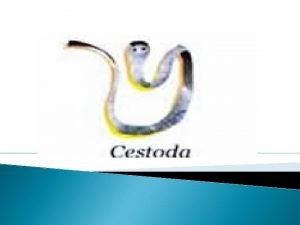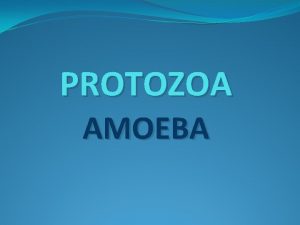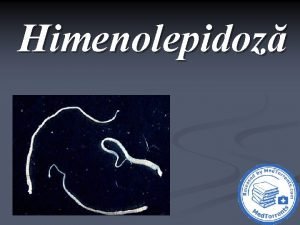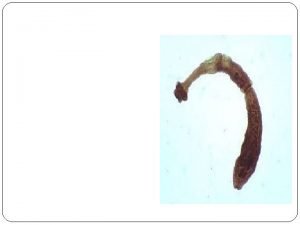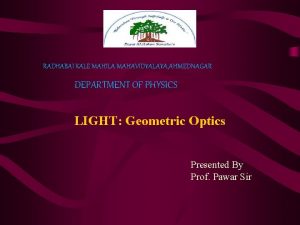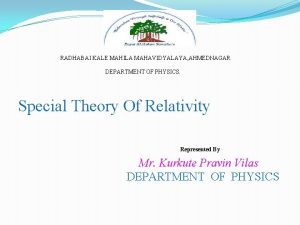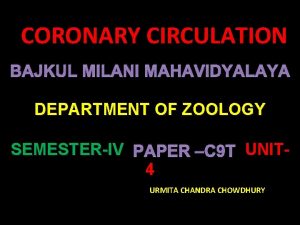DHANAJI NANA MAHAVIDYALAYA FAIZPUR Department of Chemistry An



















- Slides: 19

DHANAJI NANA MAHAVIDYALAYA, FAIZPUR Department of Chemistry An Introduction to Infrared Spectroscopy Nilesh Patil

LEARNING OBJECTIVES Describe the principal regions of the electromagnetic spectrum. � Describe the principles of infrared spectroscopy. � Describe and explain the principal factors that govern the vibrational frequencies of bonds. � Describe the Interpretation of infrared spectra �

THE ELECTROMAGNETIC SPECTRUM

WHAT IS SPECTROSCOPY? � Atoms and molecules interact with electromagnetic radiation (EMR) in a wide variety of ways. � Atoms and molecules may absorb and/or emit EMR. � Absorption of EMR stimulates different types of motion in atoms and/or molecules. � The patterns of absorption (wavelengths absorbed and to what extent) and/or emission (wavelengths emitted and their respective intensities) are called ‘spectra’. � The field of spectroscopy is concerned with the interpretation of spectra in terms of atomic and molecular structure (and environment).

INFRARED SPECTROSCOPY �Infrared radiation stimulates molecular vibrations. �Infrared spectra are traditionally displayed as %T (percent transmittance) versus wave number (4000 -400 cm-1). �Useful in identifying presence or absence of functional groups.

INFRARED SPECTROSCOPY � In the IR region of the electromagnetic spectrum, the absorption of radiation by a sample is due to changes in the vibrational energy states of a molecule.

INFRARED SPECTROSCOPY � Methane H H C Asymmetrical stretching Symmetrical stretching H H H C H H Rocking or in plane bending H H Bending or scissoring H H C C H H H C H Twisting or outof-plane bending H H Wagging or out -of-plane bending

INFRARED SPECTROSCOPY � Only vibrations that cause a change in ‘polarity’ give rise to bands in IR spectra – which of the vibrations for CO 2 are infrared active? Symmetric stretch Asymmetric stretch Bending (doubly degenerate)

INFRARED SPECTROSCOPY What is a vibration in a molecule? � Any change in shape of the molecule- stretching of bonds, bending of bonds, or internal rotation around single bonds What vibrations change the dipole moment of a molecule? � Asymmetrical stretching/bending and internal rotation change the dipole moment of a molecule. Asymmetrical stretching/bending are IR active. � Symmetrical stretching/bending does not. Not IR active

INFRARED SPECTROSCOPY � Human Breath

INFRARED SPECTROSCOPY � How much movement occurs in the vibration of a C-C bond? stretching vibration 154 pm 10 pm bending vibration 4 o For a C-C bond with a bond length of 154 pm, the variation is about 10 pm. For C-C-C bond angle a change of 4 o is 10 pm typical. This moves a carbon atom about 10 pm.

INFRARED SPECTROSCOPY What wavelength of electromagnetic radiation is involved in causing vibrations in molecules? § Infrared (IR) electromagnetic radiation causes vibrations in molecules (wavelengths of 2500 -15, 000 nm or 2. 5 – 15 mm) How does the mass influence the vibration? § The greater the mass - the lower the wavenumber H 2 I 2

INFRARED SPECTROSCOPY Ethane Chloroethane

INFRARED SPECTROSCOPY POSITION STRENGTH WIDTH REDUCED MASS LIGHT ATOMS HIGH FREQUENCY BOND STRENGTH (STIFFNESS) STRONG BONDS HIGH FREQUENCY CHANGE IN ‘POLARITY’ STRONGLY POLAR BONDS GIVE INTENSE BANDS HYDROGEN BONDING STRONG HYDROGEN BONDING GIVES BROAD BANDS

INFRARED SPECTROSCOPY � In general Bond /cm-1 C-H C-D C-O C-Cl 3000 2200 1100 700 C O C=O C-O 2143 1715 1100

INFRARED SPECTROSCOPY 4000 -3000 cm-1 3000 -2000 cm-1 2000 -1500 cm-1 1500 -1000 cm-1 O-H N-H C C C N C=C C=O C-F C-Cl deformations Increasing energy Increasing frequency

INTERPRETATION OF INFRARED SPECTRA � � � � An element of judgement is required in interpreting IR spectra but you should find that it becomes relatively straightforward with practice. It is often possible to assign the peaks in the 1600 -3600 cm-1 region by consulting tables or databases of IR spectra. When making an assignment, give both the type of bond and the type of vibration, e. g. O-H stretch or C-H bending vibration. The most useful regions are as follows: 1680 -1750 cm-1: C=O stretches feature very strongly in IR spectra and the type of carbonyl group can be determined from the exact position of the peak. 2700 -3100 cm-1: different types of C-H stretching vibrations. 3200 -3700 cm-1: various types of O-H and N-H stretching vibrations. Too many bonds absorb in the region of 600 -1600 cm-1 to allow confident assignment of individual bands. However, this region is useful as a fingerprint of a molecule, i. e. if the spectrum is almost identical to an authentic reference spectrum then the structure can be assigned with some confidence.

INTERPRETATION OF INFRARED SPECTRA Ethanoic acid

Infrared Experimental Benzoic acid
 Dnm faizpur
Dnm faizpur Radhabai kale mahila mahavidyalaya ahmednagar
Radhabai kale mahila mahavidyalaya ahmednagar Kanya mahavidyalaya kharkhoda
Kanya mahavidyalaya kharkhoda Texas tech lab explosion
Texas tech lab explosion Usf chemistry department
Usf chemistry department Keralastec
Keralastec Manipal university chemistry department
Manipal university chemistry department Ib chemistry functional groups
Ib chemistry functional groups Inorganic vs organic chemistry
Inorganic vs organic chemistry Pleroserkoid
Pleroserkoid Zola nana
Zola nana Endolimax nana
Endolimax nana Hymenolepis nana huevo
Hymenolepis nana huevo Egg xiuren
Egg xiuren Nana mouskouri there's a place in my heart
Nana mouskouri there's a place in my heart Proglotid
Proglotid Saturated salt solution flotation technique
Saturated salt solution flotation technique Casoni test
Casoni test Hymenolepis diminuta
Hymenolepis diminuta Román nana
Román nana









